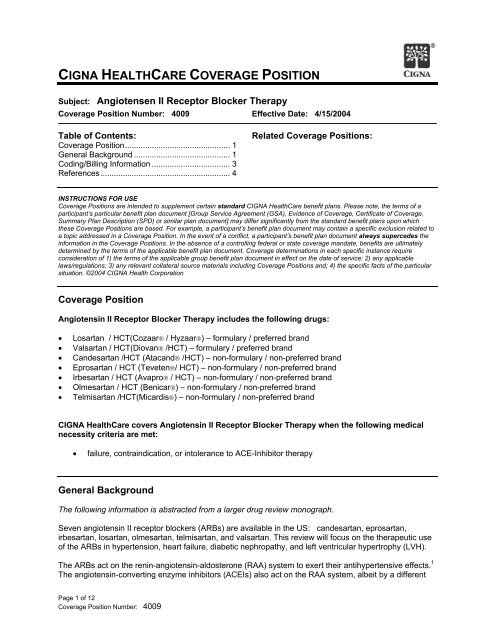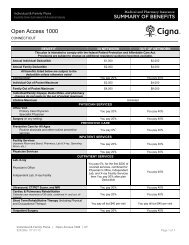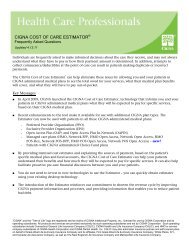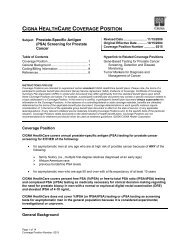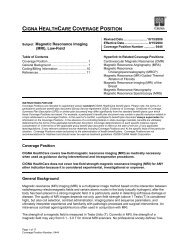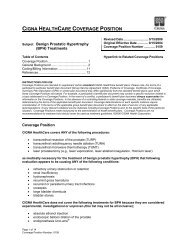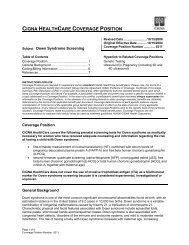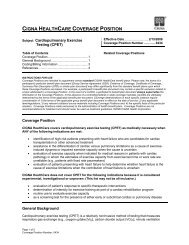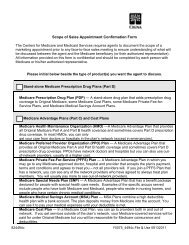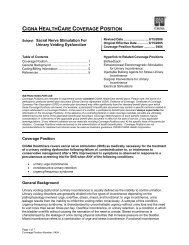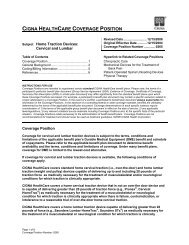Angiotensen II Receptor Blocker Therapy (4009)
Angiotensen II Receptor Blocker Therapy (4009)
Angiotensen II Receptor Blocker Therapy (4009)
Create successful ePaper yourself
Turn your PDF publications into a flip-book with our unique Google optimized e-Paper software.
CIGNA HEALTHCARE COVERAGE POSITIONSubject: <strong>Angiotensen</strong> <strong>II</strong> <strong>Receptor</strong> <strong>Blocker</strong> <strong>Therapy</strong>Coverage Position Number: <strong>4009</strong> Effective Date: 4/15/2004Table of Contents:Coverage Position............................................... 1General Background ........................................... 1Coding/Billing Information ................................... 3References.......................................................... 4Related Coverage Positions:INSTRUCTIONS FOR USECoverage Positions are intended to supplement certain standard CIGNA HealthCare benefit plans. Please note, the terms of aparticipant’s particular benefit plan document [Group Service Agreement (GSA), Evidence of Coverage, Certificate of Coverage,Summary Plan Description (SPD) or similar plan document] may differ significantly from the standard benefit plans upon whichthese Coverage Positions are based. For example, a participant’s benefit plan document may contain a specific exclusion related toa topic addressed in a Coverage Position. In the event of a conflict, a participant’s benefit plan document always supercedes theinformation in the Coverage Positions. In the absence of a controlling federal or state coverage mandate, benefits are ultimatelydetermined by the terms of the applicable benefit plan document. Coverage determinations in each specific instance requireconsideration of 1) the terms of the applicable group benefit plan document in effect on the date of service; 2) any applicablelaws/regulations; 3) any relevant collateral source materials including Coverage Positions and; 4) the specific facts of the particularsituation. ©2004 CIGNA Health CorporationCoverage PositionAngiotensin <strong>II</strong> <strong>Receptor</strong> <strong>Blocker</strong> <strong>Therapy</strong> includes the following drugs:• Losartan / HCT(Cozaar® / Hyzaar®) – formulary / preferred brand• Valsartan / HCT(Diovan® /HCT) – formulary / preferred brand• Candesartan /HCT (Atacand® /HCT) – non-formulary / non-preferred brand• Eprosartan / HCT (Teveten®/ HCT) – non-formulary / non-preferred brand• Irbesartan / HCT (Avapro® / HCT) – non-formulary / non-preferred brand• Olmesartan / HCT (Benicar®) – non-formulary / non-preferred brand• Telmisartan /HCT(Micardis®) – non-formulary / non-preferred brandCIGNA HealthCare covers Angiotensin <strong>II</strong> <strong>Receptor</strong> <strong>Blocker</strong> <strong>Therapy</strong> when the following medicalnecessity criteria are met:• failure, contraindication, or intolerance to ACE-Inhibitor therapyGeneral BackgroundThe following information is abstracted from a larger drug review monograph.Seven angiotensin <strong>II</strong> receptor blockers (ARBs) are available in the US: candesartan, eprosartan,irbesartan, losartan, olmesartan, telmisartan, and valsartan. This review will focus on the therapeutic useof the ARBs in hypertension, heart failure, diabetic nephropathy, and left ventricular hypertrophy (LVH).The ARBs act on the renin-angiotensin-aldosterone (RAA) system to exert their antihypertensive effects. 1The angiotensin-converting enzyme inhibitors (ACEIs) also act on the RAA system, albeit by a differentPage 1 of 12Coverage Position Number: <strong>4009</strong>
mechanism. The ACEIs prevent the conversion of angiotensin I to angiotensin <strong>II</strong>, by binding reversiblywith angiotensin converting enzyme (ACE). 2 The ARBs reversibly inhibit the binding of angiotensin <strong>II</strong> toangiotensin subtype 1 (AT 1 ) receptors. 1 Similar to the ACEIs, the ARBs decrease peripheral vascularresistance without increasing heart rate. 3, 4The RAA system helps regulate arterial pressure, both acutely and chronically. 1 Renin is released fromthe kidney in response to apparent decreases in arterial pressure, blood volume, and total peripheralresistance, as well as other stimuli. Renin catalyzes the formation of angiotensin I from angiotensinogen.Angiotensin I is later converted to angiotensin <strong>II</strong> by angiotensin converting enzyme (ACE). Acutely,angiotensin <strong>II</strong> stimulates AT 1 receptors, which increases arterial pressure and inhibits further reninrelease. Cardiac preload and afterload increase, both acutely and chronically. 1 Other chronic effects ofangiotensin <strong>II</strong> include ventricular hypertrophy, reduced vessel wall compliance, 5 and aldosteroneproduction and secretion. 1, 4 Many head-to-head trials have been conducted between the ARBs inpatients with hypertension. However, no data exist for establishing equivalent doses for switchingbetween agents. The dosage of each agent must be titrated for the individual patient to achieve maximalefficacy.HypertensionHypertension, the second most common risk factor for cardiovascular disease, affects over 30 millionAmericans. 82 Disease prevalence increases after the age of 30 years and is higher in minorities than inthe general population. In African-Americans, hypertension occurs at an earlier age and is more severe.Hypertension may progress to LVH and heart failure if left untreated, in addition to increasing the risk ofatherosclerosis and nephrosclerotic renal failure. 82The ARBs are not considered first-line agents for treating hypertension in the general population. 83However, the ARBs are useful for specific patients who cannot tolerate therapy with ACEIs. The sixthreport of the Joint National Committee on Prevention, Detection, Evaluation, and Treatment of High BloodPressure (JNC VI) recommends ACEIs as first-line agents in hypertensive patients with diabetes mellitus(type 1 or 2) with proteinuria, heart failure, or after myocardial infarction. 83 The 1999 WHO/ISHHypertension guidelines recommend either an ARB or an ACEI for patients with heart failure. The 2001Canadian recommendations for high blood pressure advocate an ACEI or and ARB as first line therapyfor patients with diabetes mellitus (type 1 or 2) with nephropathy. 84 Because many patients cannottolerate an ACEI, it is reasonable to substitute an ARB in patients with these conditions who cannottolerate ACEIs. 85 Additionally, there is some evidence that first-line therapy with an ARB can decrease thenumber of clinic visits required because no additional visits are required to manage adverse effects. 82Similar to the ACEIs, the ARBs can be added as a second or third agent for patients with inadequateblood pressure lowering during monotherapy. Because only 50% of patients achieve a blood pressurebelow 140/90 mmHg with a single agent, the ACEIs and ARBs may provide the additional hypotensiveeffect necessary to lower cardiac risk. 86 In diabetic patients, blood pressure should be lowered below130/80 mmHg. 87Heart Failure91, 92Heart failure is a common disorder, affecting almost 5 million Americans. Between 400,000 to700,000 cases are diagnosed annually. Prevalence increases with age, affecting almost 10% ofAmericans in their 80s. Each year, heart failure accounts for more than 3 million hospitalizations, 12-15million office visits, and up to 350,000 deaths, either directly or indirectly. The direct medical costs are91, 92more than $20 billion annually.The most current treatment guidelines recommend combination therapy with a diuretic, an ACEI, a betaadrenergicblocker, and digoxin for routine management. 91, 92 Spironolactone, ARBs, hydralazine, andisosorbide dinitrate are not recommended for routine use but may be beneficial in specific patientsubgroups. Spironolactone may be used in patients with Class IV symptoms, provided renal function andpotassium concentrations are normal. The ARBs are considered an alternative in patients who cannottolerate therapy with an ACEI due to cough or angioedema. Combination therapy with hydralazine andisosorbide dinitrate is recommended when ACEIs are contraindicated due to hypotension or renalPage 2 of 12Coverage Position Number: <strong>4009</strong>
insufficiency. An ARB may be used in conjunction with an ACEI although there is less evidence to supportthe efficacy of this combination. Patients with refractory heart failure are treated similarly but should also91, 92be referred for cardiac transplantation when appropriate.Diabetic NephropathyDiabetic nephropathy accounts for 40% of new end-stage renal disease (ESRD) in the United States. 93Fewer patients with type 2 diabetes progress to ESRD than patients with type 1 diabetes, although 20 to30% of all patients with diabetes (type 1 or 2) will develop evidence of nephropathy. 93 The cost of treatingdiabetic patients with ESRD was more than $15.6 billion dollars in 1997. 93 To reduce the risk or slow theprogression of nephropathy, the American Diabetes Association (ADA) recommends optimizing glucosecontrol. For patients with nephropathy, the ADA recommends optimizing glucose control and treatmentwith an ACEI or an ARB. Evidence shows that both ACEIs and ARBs can slow the progression ofnephropathy in patients with type 2 diabetes. 93, 94 There is no current evidence that ARBs slow theprogression of nephropathy in patients with type 1 diabetes, although the ADA recommends substitutingbetween the ACEIs and ARBs if one class is not tolerated. 93 Restricting protein intake to the current adultrecommended daily allowance (RDA) may also be of some benefit in patients with nephropathy. 93 Thereis some evidence that calcium channel-blockers may be efficacious in patients with diabetic nephropathy,94, 95however these agents are currently not recommended as first line therapy by the ADA.Left Ventricular HypertrophyLeft ventricular hypertrophy, which results from long-standing hypertension, is a marker for increasedcardiovascular morbidity and mortality. 99-101 Most antihypertensive agents reduce LVH to some degree,however the ACEIs and ARBs are the most widely studied for this purpose. 101 Levy, et al. 99 first describedthe prognostic implications of LVH in 1990 based on results of the Framingham Heart Study. These datashowed that LVH can increase the risk of cardiovascular morbidity and death after adjustment for othercardiac risk factors such as age, cholesterol profile, electrocardiographic evidence of LVH, smoking,diabetes, obesity, blood pressure, and treatment of hypertension. 99, 100 Healthy patients with LVH (>143g/m 2 for men and >102 g/m 2 for women) followed for 4 years had a relative risk of cardiovascular death of1.73 for men and 2.12 for women, compared to patients without LVH. The relative risk of all-causemortality was also higher in those with LVH (1.49 for men and 2.01 for women). 99Results from the LIFE study 73 question the use of LVH as a marker for increased cardiovascular morbidityand mortality. 102 These authors found no difference in cardiovascular mortality with losartan despite LVHregression. 73 Additional study is needed to determine the true value of LVH reduction in reducingmorbidity and mortality.SummarySeven ARBs are available in the U.S. for therapeutic use: candesartan, eprosartan, irbesartan, losartan,olmesartan, telmisartan, and valsartan. Several head-to-head trials have been conducted between theindividual ARBs in patients with hypertension. Since limited data are available to suggest that efficacydifferences exist between the individual ARBs, treatment decisions must be based on other factors,including side effects, patient preference and cost.Coding/Billing InformationNote: This list of codes may not be all-inclusive.Covered when medically necessary:CPT ® *CodesDescriptionPage 3 of 12Coverage Position Number: <strong>4009</strong>
HCPCSCodesDescriptionICD-9-CMDiagnosisCodesDescriptionExperimental/Investigational/Unproven/Not Covered:CPT* CodesDescriptionHCPCSCodesDescriptionICD-9-CMDiagnosisCodesDescription*Current Procedural Terminology (CPT ® ) © 2003 American Medical Association: Chicago, IL.ReferencesThe following lists the complete references used within a larger drug review monograph. To obtain a copyof the full drug review monograph, please contact the Pharmacy Service Center at 800.832.3211.1. Jackson EK. Renin and angiotensin. In: Hardman JG, Limbird LE, Gilman AG, eds. Goodman &Gilman's The Pharmacological Basis of Therapeutics. 10th edition. New York, NY: McGraw-HillHealth Professions Division, 2001: 809-841.2. Brogden RN, Todd PA, Sorkin EM. Captopril. An update of its pharmacodynamic andpharmacokinetic properties, and therapeutic use in hypertension and congestive heart failure.Drugs 1988; 36: 540-600.3. Brown NJ, Vaughan DE. Angiotensin-converting enzyme inhibitors. Circulation 1998; 97: 1411-20.4. Kang PM, Landau AJ, Eberhardt RT, Frishman WH. Angiotensin <strong>II</strong> receptor antagonists: A newapproach to blockade of the renin-angiotensin system. Am Heart J 1994; 127: 1388-401.5. Todd PA, Benfield P. Ramipril. A review of its pharmacological properties and therapeutic efficacyin cardiovascular disorders. Drugs 1990; 39: 110-35.6. Hebel SK, Burnham T. Drug Facts and Comparisons (updated monthly). St. Louis, MO: Facts andComparisons, Inc, 2002.7. Atacand (candesartan cilexetil) tablets package insert. Wayne, PA: AstraZeneca, September2002.8. Mosby's GenRx. The complete reference for generic and brand drugs. St. Louis, MO: Mosby Inc.,2002.Page 4 of 12Coverage Position Number: <strong>4009</strong>
9. Micardis (telmisartan) tablets, 20 mg, 40 mg and 80 mg package insert. Ridgefield, CT: BoehringerIngelheim Pharmaceuticals, November 1998.10. McClellan KJ, Goa KL. Candesartan cilexetil. A review of its use in essential hypertension. Drugs1998; 56: 847-69.11. McClellan KJ, Balfour JA. Eprosartan. Drugs 1998; 55: 713-8.12. McClellan KJ, Markham A. Telmisartan. Drugs 1998; 56: 1039-44.13. Markham A, Goa KL. Valsartan. A review of its pharmacology and therapeutic use in essentialhypertension. Drugs 1997; 54: 299-311.14. Gillis JC, Markham A. Irbesartan. A review of its pharmacodynamic and pharmacokinetic propertiesand therapeutic use in the management of hypertension. Drugs 1997; 54: 885-902.15. Goa KL, Wagstaff AJ. Losartan potassium. A review of its pharmacology, clinical efficacy andtolerability in the management of hypertension. Drugs 1996; 51: 820-45.16. Teveten (eprosartan mesylate) 400 mg and 600 mg package insert. Morrisville, NC: BiovailPharmaceuticals, Inc., June 2002.17. Teveten HCT (eprosartan mesylate/hydrochlorothiazide) 600/12.5 mg and 600/25 mg packageinsert. Morrisville, NC: Biovail Pharmaceuticals, Inc., June 2002.18. Atacand HCT (candesartan cilexetil-hydrochlorothiazide) 16-12.5 and 32-12.5 tablets packageinsert. Wayne, PA: AstraZeneca, September 2001.19. Benicar tablets (olmesartan medoxomil) package insert. New York, NY: Sankyo Pharma, 2002.20. Diovan (valsartan) tablets package insert. East Hanover, NJ: Novartis PharmaceuticalsCorporation, August 2002.21. Diovan HCT (valsartan and hydrochlorothiazide) combination tablets 80 mg/12.5 mg, 160 mg/12.5mg, and 160 mg/25 mg package insert. East Hanover, NJ: Novartis Pharmaceuticals Corporation,January 2002.22. Cozaar (losartan potassium tablets) package insert. Whitehouse Station, NJ: Merck & CompanyInc., August 2002.23. Hyzaar 50-12.5 and Hyzaar 100-25 (losartan potassium-hydrochlorothiazide tablets) packageinsert. Whitehouse Station, NJ: Merck & Company Inc., November 2001.24. Avapro (irbesartan) tablets and Avalide (irbesartan-hydrochlorothiazide) tablets package insert.New York, NY: Bristol-Myers Squibb Company, August 2002.25. Hansten PD, Horn JR. Hansten and Horn's Drug Interactions Analysis and Management.Vancouver, WA: Applied Therapeutics, Inc., 2003.26. Micardis HCT (telmisartan and hydrochlorothiazide) tablets, 40 mg/12.5 mg and 80 mg/12.5 mgpackage insert. Ridgefield, CT: Boehringer Ingelheim Pharmaceuticals, November 2000.27. Conlin PR, Spence JD, Williams B, Ribeiro AB, Saito I, Benedict C, Bunt AM. Angiotensin <strong>II</strong>antagonists for hypertension: are there differences in efficacy? Am J Hypertens 2000; 13: 418-26.28. Conlin PR. Angiotensin <strong>II</strong> Antagonists in the Treatment of Hypertension: More Similarities ThanDifferences. J Clin Hypertens (Greenwich) 2000; 2: 253-257.Page 5 of 12Coverage Position Number: <strong>4009</strong>
29. Ball KJ, Williams PA, Stumpe KO. Relative efficacy of an angiotensin <strong>II</strong> antagonist compared withother antihypertensive agents. Olmesartan medoxomil versus antihypertensives. J Hypertens Suppl2001; 19 Suppl 1: S49-56.30. Oparil S, Williams D, Chrysant SG, Marbury TC, Neutel J. Comparative efficacy of olmesartan,losartan, valsartan, and irbesartan in the control of essential hypertension. J Clin Hypertens(Greenwich) 2001; 3: 283-91, 318.31. Oparil S. Comparative antihypertensive efficacy of olmesartan: comparison with other angiotensin<strong>II</strong> receptor antagonists. J Hum Hypertens 2002; 16 Suppl 2: S17-23.32. Neutel JM, Smith DH, Reilly PA. The efficacy and safety of telmisartan compared to enalapril inpatients with severe hypertension. Int J Clin Pract 1999; 53: 175-8.33. Larochelle P, Flack JM, Marbury TC, Sareli P, Krieger EM, Reeves RA. Effects and tolerability ofirbesartan versus enalapril in patients with severe hypertension. Irbesartan MulticenterInvestigators. Am J Cardiol 1997; 80: 1613-5.34. Ruff D, Gazdick LP, Berman R, Goldberg AI, Sweet CS. Comparative effects of combination drugtherapy regimens commencing with either losartan potassium, an angiotensin <strong>II</strong> receptorantagonist, or enalapril maleate for the treatment of severe hypertension. J Hypertens 1996; 14:263-70.35. Sega R. Efficacy and safety of eprosartan in severe hypertension. Eprosartan Multinational StudyGroup. Blood Press 1999; 8: 114-21.36. Oparil S, Levine JH, Zuschke CA, et al. Effects of candesartan cilexetil in patients with severesystemic hypertension. Candesartan Cilexetil Study Investigators. Am J Cardiol 1999; 84: 289-93.37. Oparil S. Candesartan cilexetil in combination with low-dose hydrochlorothiazide is effective insevere hypertension. Am J Cardiol 1999; 84: 35S-41S.38. Weir MR, Weber MA, Neutel JM, Vendetti J, Michelson EL, Wang RY. Efficacy of candesartancilexetil as add-on therapy in hypertensive patients uncontrolled on background therapy: a clinicalexperience trial. ACTION Study Investigators. Am J Hypertens 2001; 14: 567-72.39. Stergiou GS, Skeva, <strong>II</strong>, Baibas NM, Roussias LG, Kalkana CB, Achimastos AD, Mountokalakis TD.Additive hypotensive effect of angiotensin-converting enzyme inhibition and angiotensin-receptorantagonism in essential hypertension. J Cardiovasc Pharmacol 2000; 35: 937-41.40. Rosenstock J, Rossi L, Lin CS, MacNeil D, Osbakken M. The effects of irbesartan added tohydrochlorothiazide for the treatment of hypertension in patients non-responsive tohydrochlorothiazide alone. J Clin Pharm Ther 1998; 23: 433-40.41. Soffer BA, Wright JT, Jr., Pratt JH, Wiens B, Goldberg AI, Sweet CS. Effects of losartan on abackground of hydrochlorothiazide in patients with hypertension. Hypertension 1995; 26: 112-7.42. Gradman AH, Lewin A, Bowling BT, Tonkon M, Deedwania PC, Kezer AE, et al. Comparativeeffects of candesartan cilexetil and losartan in patients with systemic hypertension. CandesartanVersus Losartan Efficacy Comparison (CANDLE) Study Group. Heart Dis 1999; 1: 52-7.43. Levine B. Effect of eprosartan and enalapril in the treatment of black hypertensive patients:subgroup analysis of a 26-week, double-blind, multicentre study. Eprosartan Multinational StudyGroup. Curr Med Res Opin 1999; 15: 25-32.44. Weir MR, Smith DH, Neutel JM, Bedigian MP. Valsartan alone or with a diuretic or ACE inhibitor astreatment for African American hypertensives: relation to salt intake. Am J Hypertens 2001; 14:665-71.Page 6 of 12Coverage Position Number: <strong>4009</strong>
45. Flack JM, Saunders E, Gradman A, Kraus WE, Lester FM, Pratt JH, et al. Antihypertensive efficacyand safety of losartan alone and in combination with hydrochlorothiazide in adult African Americanswith mild to moderate hypertension. Clin Ther 2001; 23: 1193-208.46. McGill JB, Reilly PA. Combination treatment with telmisartan and hydrochlorothiazide in blackpatients with mild to moderate hypertension. Clin Cardiol 2001; 24: 66-72.47. Hannedouche T, Chanard J, Baumelou B. Evaluation of the safety and efficacy of telmisartan andenalapril, with the potential addition of frusemide, in moderate-renal failure patients with mild-tomoderatehypertension. J Renin Angiotensin Aldosterone Syst 2001; 2: 246-54.48. Schulz E, Bech JN, Pedersen EB, Muller GA. A randomized, double-blind, parallel study on thesafety and antihypertensive efficacy of losartan compared to captopril in patients with mild tomoderate hypertension and impaired renal function. Nephrol Dial Transplant 1999; 14 Suppl 4: 27-8.49. Ruilope LM, Aldigier JC, Ponticelli C, Oddou-Stock P, Botteri F, Mann JF. Safety of the combinationof valsartan and benazepril in patients with chronic renal disease. European Group for theInvestigation of Valsartan in Chronic Renal Disease. J Hypertens 2000; 18: 89-95.50. Kincaid-Smith P, Fairley K, Packham D. Randomized controlled crossover study of the effect onproteinuria and blood pressure of adding an angiotensin <strong>II</strong> receptor antagonist to an angiotensinconverting enzyme inhibitor in normotensive patients with chronic renal disease and proteinuria.Nephrol Dial Transplant 2002; 17: 597-601.51. Tepel M, van der Giet M, Zidek W. Efficacy and tolerability of angiotensin <strong>II</strong> type 1 receptorantagonists in dialysis patients using AN69 dialysis membranes. Kidney Blood Press Res 2001; 24:71-4.52. Jong P, Demers C, McKelvie RS, Liu PP. Angiotensin receptor blockers in heart failure: metaanalysisof randomized controlled trials. J Am Coll Cardiol 2002; 39: 463-70.53. Dunselman PH. Effects of the replacement of the angiotensin converting enzyme inhibitor enalaprilby the angiotensin <strong>II</strong> receptor blocker telmisartan in patients with congestive heart failure. Thereplacement of angiotensin converting enzyme inhibition (REPLACE) investigators. Int J Cardiol2001; 77: 131-8; discussion 139-40.54. Parker AB, Azevedo ER, Baird MG, Smith SJ, Arnold JM, Humen DP, et al. ARCTIC: assessmentof haemodynamic response in patients with congestive heart failure to telmisartan: a multicentredose-ranging study in Canada. Am Heart J 1999; 138: 843-8.55. Lacourciere Y, Belanger A, Godin C, Halle JP, Ross S, Wright N, Marion J. Long-term comparisonof losartan and enalapril on kidney function in hypertensive type 2 diabetics with early nephropathy.Kidney Int 2000; 58: 762-9.56. Andersen S, Tarnow L, Rossing P, Hansen BV, Parving HH. Renoprotective effects of angiotensin<strong>II</strong> receptor blockade in type 1 diabetic patients with diabetic nephropathy. Kidney Int2000; 57: 601-6.57. Mogensen CE, Neldam S, Tikkanen I, Oren S, Viskoper R, Watts RW, Cooper ME. Randomisedcontrolled trial of dual blockade of renin-angiotensin system in patients with hypertension,microalbuminuria, and non-insulin dependent diabetes: the candesartan and lisinoprilmicroalbuminuria (CALM) study. BMJ 2000; 321: 1440-4.58. Nakamura T, Ushiyama C, Suzuki S, Biemesderfer D, St John PL, Abrahamson DR, et al.Comparison between the angiotensin <strong>II</strong> receptor antagonist candesartan cilexetil and thePage 7 of 12Coverage Position Number: <strong>4009</strong>
angiotensin-converting enzyme inhibitor trandolapril in microalbuminuria of patients with earlydiabetic nephropathy. Nephron 2000; 86: 247.59. Lewis EJ, Hunsicker LG, Rodby RA. A clinical trial in type 2 diabetic nephropathy. Am J Kidney Dis2001; 38: S191-4.60. Lewis EJ, Hunsicker LG, Clarke WR, Berl T, Pohl MA, Lewis JB, et al. Renoprotective effect of theangiotensin-receptor antagonist irbesartan in patients with nephropathy due to type 2 diabetes. NEngl J Med 2001; 345: 851-60.61. Viberti G, Wheeldon NM. Microalbuminuria reduction with valsartan in patients with type 2 diabetesmellitus: a blood pressure-independent effect. Circulation 2002; 106: 672-8.62. Rossing K, Christensen PK, Jensen BR, Parving HH. Dual blockade of the renin-angiotensinsystem in diabetic nephropathy: a randomized double-blind crossover study. Diabetes Care 2002;25: 95-100.63. Hebert LA, Falkenhain ME, Nahman NS, Jr., Cosio FG, O'Dorisio TM. Combination ACE inhibitorand angiotensin <strong>II</strong> receptor antagonist therapy in diabetic nephropathy. Am J Nephrol 1999; 19: 1-6.64. Suzuki K, Souda S, Ikarashi T, Kaneko S, Nakagawa O, Aizawa Y. Renoprotective effects of lowdosevalsartan in type 2 diabetic patients with diabetic nephropathy. Diabetes Res Clin Pract 2002;57: 179-83.65. Rippin J, Bain SC, Barnett AH. Rationale and design of diabetics exposed to telmisartan andenalapril (DETAIL) study. J Diabetes Complications 2002; 16: 195-200.66. De Rosa ML, Cardace P, Rossi M, Baiano A, de Cristofaro A. Comparative effects of chronic ACEinhibition and AT1 receptor blocked losartan on cardiac hypertrophy and renal function inhypertensive patients. J Hum Hypertens 2002; 16: 133-40.67. Shibasaki Y, Masaki H, Nishiue T, Nishikawa M, Matsubara H, Iwasaka T. Angiotensin <strong>II</strong> type 1receptor antagonist, losartan, causes regression of left ventricular hypertrophy in end-stage renaldisease. Nephron 2002; 90: 256-61.68. Nalbantgil S, Yilmaz H, Gurun C, Ozerkan F, Nalbantgil I, Onder R. Effects of valsartan andenalapril on regression of left ventricular hypertrophy in patients with mild to moderatehypertension: a randomized, double-blind study. Curr Ther Res Clin Exp 2000; 61: 331-8.69. Malmqvist K, Kahan T, Edner M, Bergfeldt L. Comparison of actions of irbesartan versus atenololon cardiac repolarization in hypertensive left ventricular hypertrophy: results from the SwedishIrbesartan Left Ventricular Hypertrophy Investigation Versus Atenolol (SILVHIA). Am J Cardiol2002; 90: 1107-12.70. Malmqvist K, Kahan T, Edner M, Held C, Hagg A, Lind L, et al. Regression of left ventricularhypertrophy in human hypertension with irbesartan. J Hypertens 2001; 19: 1167-76.71. Dahlof B, Devereux R, de Faire U, Fyhrquist F, Hedner T, Ibsen H, et al. The Losartan InterventionFor Endpoint reduction (LIFE) in Hypertension study: rationale, design, and methods. The LIFEStudy Group. Am J Hypertens 1997; 10: 705-13.72. Dahlof B, Devereux RB, Julius S, Kjeldsen SE, Beevers G, de Faire U, et al. Characteristics of9194 patients with left ventricular hypertrophy: the LIFE study. Losartan Intervention For EndpointReduction in Hypertension. Hypertension 1998; 32: 989-97.73. Dahlof B, Devereux RB, Kjeldsen SE, Julius S, Beevers G, de Faire U, et al. Cardiovascularmorbidity and mortality in the Losartan Intervention For Endpoint reduction in hypertension study(LIFE): a randomised trial against atenolol. Lancet 2002; 359: 995-1003.Page 8 of 12Coverage Position Number: <strong>4009</strong>
74. Kjeldsen SE, Dahlof B, Devereux RB, Julius S, Aurup P, Edelman J, et al. Effects of losartan oncardiovascular morbidity and mortality in patients with isolated systolic hypertension and leftventricular hypertrophy: a Losartan Intervention for Endpoint Reduction (LIFE) substudy. JAMA2002; 288: 1491-8.75. Tedesco MA, Ratti G, Aquino D, Limongelli G, di Salvo G, Mennella S, et al. Effects of losartan onhypertension and left ventricular mass: a long-term study. J Hum Hypertens 1998; 12: 505-10.76. Thurmann PA. Angiotensin <strong>II</strong> antagonism and the heart: valsartan in left ventricular hypertrophy.Cardiology 1999; 91 Suppl 1: 3-7.77. Thurmann PA, Kenedi P, Schmidt A, Harder S, Rietbrock N. Influence of the angiotensin <strong>II</strong>antagonist valsartan on left ventricular hypertrophy in patients with essential hypertension.Circulation 1998; 98: 2037-42.78. Thurmann PA. Angiotensin <strong>II</strong> antagonism and the heart: valsartan in left ventricular hypertrophy. JCardiovasc Pharmacol 1999; 33 Suppl 1: S33-6; discussion S41-3.79. Lindholm LH, Ibsen H, Dahlof B, Devereux RB, Beevers G, de Faire U, et al. Cardiovascularmorbidity and mortality in patients with diabetes in the Losartan Intervention For Endpoint reductionin hypertension study (LIFE): a randomised trial against atenolol. Lancet 2002; 359: 1004-10.80. Mitsunami K, Inoue S, Maeda K, Endoh S, Takahashi M, Okada M, et al. Three-month effects ofcandesartan cilexetil, an angiotensin <strong>II</strong> type 1 (AT1) receptor antagonist, on left ventricular massand hemodynamics in patients with essential hypertension. Cardiovasc Drugs Ther 1998; 12: 469-74.81. Cohen A, Bregman B, Agabiti Rosei E, Williams B, Dubourg O, Clairefond P, et al. Comparison ofirbesartan vs felodipine in the regression after 1 year of left ventricular hypertrophy in hypertensivepatients (the SILVER trial). Study of Irbesartan in Left VEntricular hypertrophy Regression. J HumHypertens 1998; 12: 479-83.82. Moore MA. Improving the managed care of hypertension with angiotensin <strong>II</strong> antagonists. Am J MedSci 2002; 323: 25-33.83. The Joint National Committee on Prevention Detection Evaluation and Treatment of High BloodPressure and the National High Blood Pressure Education Program Coordinating Committee. TheSixth Report of the Joint National Committee on Prevention, Detection, Evaluation, and Treatmentof High Blood Pressure. Arch Intern Med 1997; 157: 2413-46.84. McAlister FA, Zarnke KB, Campbell NR, Feldman RD, Levine M, Mahon J, et al. The 2001Canadian recommendations for the management of hypertension: Part two--<strong>Therapy</strong>. Can J Cardiol2002; 18: 625-41.85. Moser M. Current recommendations for the treatment of hypertension: are they still valid? JHypertens 2002; 20 Suppl 1: S3-10.86. PCS Health Systems Inc. Clinical considerations: Use of ARBs in the management of hypertension.RxReview. New Trends in Prescription Therapies, Benefits, and Costs 2000; July: 1-4.87. Hansson L, Zanchetti A, Carruthers SG, Dahlof B, for the HOT Study Group. Effects of intensiveblood-pressure lowering and low-dose aspirin in patients with hypertension: Principal results of theHypertension Optimal Treatment (HOT) randomised trial. Lancet 1998; 351: 1755-62.88. Brunner HR. The new oral angiotensin <strong>II</strong> antagonist olmesartan medoxomil: a concise overview. JHum Hypertens 2002; 16 Suppl 2: S13-6.Page 9 of 12Coverage Position Number: <strong>4009</strong>
89. Stumpe KO, Ludwig M. Antihypertensive efficacy of olmesartan compared with otherantihypertensive drugs. J Hum Hypertens 2002; 16 Suppl 2: S24-8.90. Elliott WJ. Double-blind comparison of eprosartan and enalapril on cough and blood pressure inunselected hypertensive patients. Eprosartan Study Group. J Hum Hypertens 1999; 13: 413-7.91. Heart Failure Society of America (HFSA) practice guidelines. HFSA guidelines for management ofpatients with heart failure caused by left ventricular systolic dysfunction--pharmacologicalapproaches. J Card Fail 1999; 5: 357-82.92. Hunt SA, Baker DW, Chin MH, Cinquegrani MP, Feldmanmd AM, Francis GS, et al. ACC/AHAGuidelines for the Evaluation and Management of Chronic Heart Failure in the Adult: ExecutiveSummary A Report of the American College of Cardiology/American Heart Association Task Forceon Practice Guidelines (Committee to Revise the 1995 Guidelines for the Evaluation andManagement of Heart Failure): Developed in Collaboration With the International Society for Heartand Lung Transplantation; Endorsed by the Heart Failure Society of America. Circulation 2001;104: 2996-3007.93. Diabetic nephropathy. Diabetes Care 2003; 26 Suppl 1: S94-98.94. Mogensen CE. Diabetic nephropathy: evidence for renoprotection and practice. Heart 2000; 84Suppl 1: i26-8: discussion i50.95. Ruilope LM. Renoprotection and renin-angiotensin system blockade in diabetes mellitus. Am JHypertens 1997; 10: 325S-331S.96. Brenner BM, Cooper ME, de Zeeuw D, Keane WF, Mitch WE, Parving HH, et al. Effects of losartanon renal and cardiovascular outcomes in patients with type 2 diabetes and nephropathy. N Engl JMed 2001; 345: 861-9.97. Parving HH, Lehnert H, Brochner-Mortensen J, Gomis R, Andersen S, Arner P. The effect ofirbesartan on the development of diabetic nephropathy in patients with type 2 diabetes. N Engl JMed 2001; 345: 870-8.98. Lozano JV, Llisterri JL, Aznar J, Redon J. Losartan reduces microalbuminuria in hypertensivemicroalbuminuric type 2 diabetics. Nephrol Dial Transplant 2001; 16 Suppl 1: 85-9.99. Levy D, Garrison RJ, Savage DD, Kannel WB, Castelli WP. Prognostic implications ofechocardiographically determined left ventricular mass in the Framingham Heart Study. N Engl JMed 1990; 322: 1561-6.100. Lorell BH, Carabello BA. Left ventricular hypertrophy: pathogenesis, detection, and prognosis.Circulation 2000; 102: 470-9.101. Grossman E, Messerli FH, Neutel JM. Angiotensin <strong>II</strong> receptor blockers: equal or preferredsubstitutes for ACE inhibitors? Arch Intern Med 2000; 160: 1905-11.102. Messerli FH, Mehra MR. Crumbling of left ventricular hypertrophy as a surrogate end point (theLosartan for Intervention for Endpoint Reduction in Hypertension [LIFE] Study). Am J Cardiol 2002;90: 1133-4.103. Wachtell K, Palmieri V, Olsen MH, Gerdts E, Papademetriou V, Nieminen MS, et al. Change insystolic left ventricular performance after 3 years of antihypertensive treatment: the LosartanIntervention for Endpoint (LIFE) Study. Circulation 2002; 106: 227-32.104. Wachtell K, Bella JN, Rokkedal J, Palmieri V, Papademetriou V, Dahlof B, et al. Change in diastolicleft ventricular filling after one year of antihypertensive treatment: The Losartan Intervention ForEndpoint Reduction in Hypertension (LIFE) Study. Circulation 2002; 105: 1071-6.Page 10 of 12Coverage Position Number: <strong>4009</strong>
105. Wachtell K, Palmieri V, Olsen MH, Bella JN, Aalto T, Dahlof B, et al. Urine albumin/creatinine ratioand echocardiographic left ventricular structure and function in hypertensive patients withelectrocardiographic left ventricular hypertrophy: the LIFE study. Losartan Intervention for EndpointReduction. Am Heart J 2002; 143: 319-26.106. Benicar (olmesartan medoxomil) Formulary Submission. New York, NY: Sankyo Pharma Inc.,January 7, 2003.107. Wurzner G, Gerster JC, Chiolero A, Maillard M, Fallab-Stubi CL, Brunner HR, Burnier M.Comparative effects of losartan and irbesartan on serum uric acid in hypertensive patients withhyperuricaemia and gout. J Hypertens 2001; 19: 1855-60.108. Oparil S, Guthrie R, Lewin AJ, Marbury T, Reilly K, Triscari J, Witcher JA. An elective-titration studyof the comparative effectiveness of two angiotensin <strong>II</strong>-receptor blockers, irbesartan and losartan.Irbesartan/Losartan Study Investigators. Clin Ther 1998; 20: 398-409.109. Chew CG, Weise MD, Disney APS. The effect of angiotensin <strong>II</strong> receptor antagonist on theexogenous erythropoietin requirement of haemodialysis patients. Nephrol Dial Transplant 1999; 14:2047-9.110. Plosker GL, Foster RH. Eprosartan: a review of its use in the management of hypertension. Drugs2000; 60: 177-201.111. Sharpe M, Jarvis B, Goa KL. Telmisartan: a review of its use in hypertension. Drugs 2001; 61:1501-29.112. Pylypchuk GB. ACE inhibitor- versus angiotensin <strong>II</strong> blocker-induced cough and angioedema. AnnPharmacother 1998; 32: 1060-6.113. Conigliaro RL, Gleason PP. Losartan-induced cough after lisinopril therapy. Am J Health SystPharm 1999; 56: 914-5.114. Chan P, Tomlinson B, Huang TY, Ko JT, Lin TS, Lee YS. Double-blind comparison of losartan,lisinopril, and metolazone in elderly hypertensive patients with previous angiotensin-convertingenzyme inhibitor-induced cough. J Clin Pharmacol 1997; 37: 253-7.115. Lacourciere Y. The incidence of cough: a comparison of lisinopril, placebo and telmisartan, a novelangiotensin <strong>II</strong> antagonist. Telmisartan Cough Study Group. Int J Clin Pract 1999; 53: 99-103.116. Paster RZ, Snavely DB, Sweet AR, et al. Use of losartan in the treatment of hypertensive patientswith a history of cough induced by angiotensin-converting enzyme inhibitors. Clin Ther 1998; 20:978-89.117. Tanser PH, Campbell LM, Carranza J, Karrash J, Toutouzas P, Watts R. Candesartan cilexetil isnot associated with cough in hypertensive patients with enalapril-induced cough. Multicentre CoughStudy Group. Am J Hypertens 2000; 13: 214-8.118. Oparil S, The Eprosartan 053 Study Group. Comparison of eprosartan and enalapril on incidence ofcough in hypertensive patients with history of ACE inhibitor-induced cough [Abstract D023]. Am JHypertens 1998; 11 (4 Pt 2): 74A.119. Benz J, Oshrain C, Henry D, Avery C, Chiang YT, Gatlin M. Valsartan, a new angiotensin <strong>II</strong>receptor antagonist: a double-blind study comparing the incidence of cough with lisinopril andhydrochlorothiazide. J Clin Pharmacol 1997; 37: 101-7.120. Rake EC, Breeze E, Fletcher AE. Quality of life and cough on antihypertensive treatment: arandomised trial of eprosartan, enalapril and placebo. J Hum Hypertens 2001; 15: 863-7.Page 11 of 12Coverage Position Number: <strong>4009</strong>
121. Breeze E, Rake EC, Donoghue MD, Fletcher AE. Comparison of quality of life and cough oneprosartan and enalapril in people with moderate hypertension. J Hum Hypertens 2001; 15: 857-62.122. Rivera JO. Losartan-induced angioedema. Ann Pharmacother 1999; 33: 933-5.123. Boxer M. Accupril- and Cozaar-induced angioedema in the same patient. J Allergy Clin Immunol1996; 98: 471.124. Acker CG, Greenberg A. Angioedema induced by the angiotensin <strong>II</strong> blocker losartan. N Engl J Med1995; 333: 1572.125. Cha YJ, Pearson VE. Angioedema due to losartan. Ann Pharmacother 1999; 33: 936-8.126. Chiu AG, Krowiak EJ, Deeb ZE. Angioedema associated with angiotensin <strong>II</strong> receptor antagonists:challenging our knowledge of angioedema and its etiology. Laryngoscope 2001; 111: 1729-31.127. Frye CB, Pettigrew TJ. Angioedema and photosensitive rash induced by valsartan.Pharmacotherapy 1998; 18: 866-8.128. Rupprecht R, Vente C, Grafe A, Fuchs T. Angioedema due to losartan. Allergy 1999; 54: 81-2.129. Sharma PK, Yium JJ. Angioedema associated with angiotensin <strong>II</strong> receptor antagonist losartan.South Med J 1997; 90: 552-3.130. van Rijnsoever EW, Kwee-Zuiderwijk WJ, Feenstra J. Angioneurotic edema attributed to the use oflosartan. Arch Intern Med 1998; 158: 2063-5.131. Sica DA, Bakris GL. Type 2 diabetes: RENAAL and IDNT--the emergence of new treatmentoptions. J Clin Hypertens (Greenwich) 2002; 4: 52-7.132. Warner KK, Visconti JA, Tschampel MM. Angiotensin <strong>II</strong> receptor blockers in patients with ACEinhibitor-induced angioedema. Ann Pharmacother 2000; 34: 526-8.133. Howes LG, Tran D. Can angiotensin receptor antagonists be used safely in patients with previousACE inhibitor-induced angioedema? Drug Saf 2002; 25: 73-6.Page 12 of 12Coverage Position Number: <strong>4009</strong>


